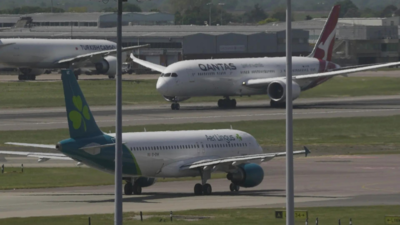Global Market Turmoil: The Ripple Effects of Tariff Wars

NEW DELHI: A profound global market turmoil intensified on Monday, a wave of panic sweeping through trading floors around the world following a controversial announcement from U.S. President Donald Trump, unveiling sweeping tariffs on numerous imports. In a swift response, Beijing announced retaliatory measures that would impose a staggering 34% tariff on all imports from the U.S., effective April 10. This rapid escalation in trade tensions fueled fears of a looming global trade war, sending investor sentiment spiraling downward.
Across Asia, stock markets experienced significant drops, with analysts estimating that over $9 trillion in market value has been obliterated in just two days. This sharp decline has drawn eerie comparisons to the catastrophic financial crisis of 2008, leaving investors and economists alike in a state of alarm. As Wall Street braces for further declines in light of Friday’s staggering market performance, where the S&P 500 plummeted by 6%, the Dow Jones Industrial Average fell by 5.5%, and the Nasdaq Composite dropped by 5.8%, traders are left wondering what steps might be taken to stabilize the volatile markets.
In India, the equity benchmark indices—the BSE Sensex and the Nifty50—saw a dramatic crash in early trading on Monday, plummeting more than 3.5% as the global market chaos rattled local investor confidence. At precisely 9:15 AM, the Sensex reported a significant loss of 2,567 points, marking a 3.41% decrease, trading at 72,797.97. Similarly, the Nifty50 suffered an 838-point drop, a 3.66% decline, bringing it down to 22,066.10. This latest collapse was a continuation of a selloff observed the previous week, where benchmark indices had already dipped over 2.5% after a prolonged phase of market consolidation.
Financial analysts attribute this downturn to escalating concerns over a global trade war and adverse external factors, particularly influenced by the recent U.S. tariff actions. In response to the market volatility, a senior official from India's finance ministry reassured the public, stating that the country remains on track to meet its fiscal year 2026 GDP growth target of 6.3%–6.8%, provided that crude oil prices do not exceed $70 per barrel.
In South Korea, the influential Kospi index suffered its own losses, dropping 5.5%, largely due to downturns in the technology and manufacturing sectors. Given South Korea's heavy reliance on exports to both the U.S. and China, the nation now faces dual challenges stemming from international trade disputes. Meanwhile, Taiwan's recent decision to restrict short selling momentarily raised hopes for market stabilization, but this was short-lived as regional sell-offs persisted.
Kevin Hassett, the head of the U.S. National Economic Council, reported, “More than 50 countries have reached out to the president to begin negotiations.” In Japan, the Nikkei 225 took a nose-dive, plummeting 7.1%, with intra-day losses nearing 8%. Investors flocked to traditional safe-haven assets, resulting in the yen strengthening to 145.98 against the dollar. In the commodities market, U.S. crude oil prices fell below $60 per barrel for the first time since April 2021, a clear indication of prevailing global demand concerns.
Despite the chaos, President Trump remained unshaken, declaring, “Sometimes you have to take medicine to fix something.” In an equally dramatic turn, Beijing’s response to Trump’s tariffs included implementing a 34% duty on all imports from the U.S., sending the Shanghai Composite Index down by 6.5%. The Chinese Commerce Ministry described the tariffs as a direct countermeasure to what they termed U.S. “aggression,” further stoking fears of a prolonged trade standoff.
Federal Reserve Chair Jerome Powell expressed concerns that the trade conflict could lead to higher inflation rates and hinder economic growth. Following Friday’s significant market crash, U.S. futures indicated more potential losses on the horizon. Trump, however, doubled down on his optimistic rhetoric, proclaiming, “THIS IS A GREAT TIME TO GET RICH.” In contrast, Powell asserted the Fed’s obligation to keep long-term inflation expectations firmly anchored, hinting at the delicate balance the Fed must maintain in response to the crisis.
Specific companies like GE Healthcare and DuPont suffered double-digit losses amid fears of impending regulatory crackdowns from Beijing. Trading resumed in Taiwan after a holiday, resulting in the Taiex index falling by 9.8%. Regulatory authorities in Taiwan swiftly introduced temporary restrictions on short selling, aiming to prevent further market decline. President Lai Ching-te indicated that Taiwan would not impose retaliatory tariffs but instead seek to negotiate a zero-tariff deal with Washington while announcing a significant $2.7 billion stimulus package to mitigate domestic impacts.
Australia's ASX 200 took a severe hit, sinking by 6.3% to reach its lowest level in nearly 15 months. Prime Minister Anthony Albanese remarked, “You can’t change global events. What you can do is prepare for them.” The U.S. administration's imposition of a 10% tariff on Australian goods has only intensified fears of an impending recession.
In Singapore, the Straits Times Index crashed by 8.5%, representing one of the steepest drops in the region. The city-state's heavy reliance on global trade has rendered it particularly vulnerable to the ongoing tariff war. South Korea's KOSPI index fell by 5.26%, triggering a so-called sidecar mechanism that momentarily halted some trading for the first time in eight months. An academic at Sejong University in Seoul, Kim Dae-jong, highlighted that South Korea's economic fate is closely tied to its trade relations, noting, “When the U.S. imposes excessively high tariffs, we become one of the hardest-hit economies.”
In the UK, markets were closed as of the time of reporting, but expectations pointed towards a sharp decline upon re-opening. Prime Minister Keir Starmer, in an op-ed, addressed the crisis, stating, “The world as we knew it has gone,” and called for a renewed focus on establishing “deals and alliances.” In the Gulf region, Saudi markets suffered their worst day since the pandemic, plunging by 6.78% as shares in the oil giant Aramco tumbled by 6.2%, resulting in a loss of over $133 billion in market value. Other Gulf nations, including Kuwait, Qatar, and Oman, reported notable losses of 5.7%, 4.2%, and 2.6%, respectively.
According to a report by state-run Al-Ekhbariya, “Trump’s tariffs weighed heavily on global markets, specifically impacting Saudi markets.” As the global economic climate continues to waver precariously, central banks find themselves under increasing pressure to take action. However, Powell indicated a cautious approach, stating, “A one-time increase in the price level must not become an ongoing inflation problem.” The Fed now faces a challenging dilemma: to cut interest rates to alleviate economic pain or maintain a firm stance to prevent runaway inflation.
As panic ripples across global markets, investor sentiment remains hinged on the hope that diplomacy may prevail over confrontation. As President Trump succinctly put it, “They’re dying to make a deal.”





















